INDIA
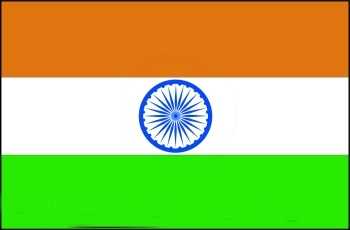
India has long been on our ‘must see’ list, and we finally made it there. Although we covered a lot of territory on land, by air, and over water, we actually saw very little of the vast country. We started our trip in the capital of Delhi, and moved to the southeast as far as Kolkata. What we saw was a beautiful country with delightful people. Given the opportunity, we would gladly return to see more of this exciting land.
The history of the area that now comprises India dates back more than 250,000 years. It has a very long and colorful history. Anything more than the most basic overview of that history is beyond the scope of this site. Therefore, the following is only a brief review of some of the highlights – and lowlights – in this country’s interesting history.
For brevity, the following discussion of India’s history is divided in to four eras of varying duration. Those eras are way back in time, the age of Mahavira and Buddha, the age of empire, and independence.
Archeological evidence suggests that the Indus Valley has been populated since around 250,000 BC. There is evidence of agricultural settlements dating back to around 7,000 BC, and urban civilizations date back to around 2,500 BC.
The Vedic Age dates from around 1,500 BC to the 6th century BC. During this time, Aryan immigrants formed a mixed pastoral and agrarian economy. They also developed a caste system and required that sacrifices were made to the gods.
The 6th century BC gave rise to many urban centers in the north. From these urban centers emerged two new philosophical paths that attracted much of the population. The paths were Jainism as described by Vardhamana Mahavira (540-467 BC) and Buddhism as described by Gautama Siddhartha (566-486 BC). These paths did not have a caste system, they did not require sacrifice, and they were open to all – including women.
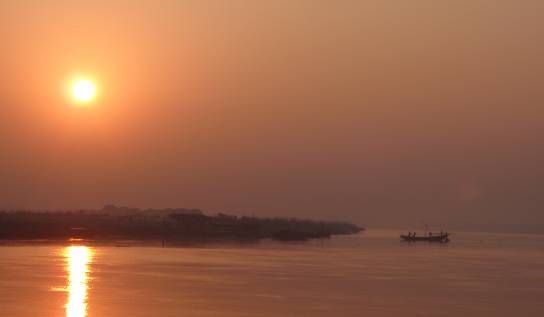
What is now India would be ruled by a series of foreign empires for more than 2,000 years. It began with the Mauryan Empire in 321 BC and ended with the British Empire in 1947.
Mauryan Empire: In 321 BC, Chandragupta Maurya and his troops defeated the ruling Nanda dynasty in northern India and established his rule over what is now India. His grandson, Ashoka (269-232 BC) extended that empire until he renounced violence and embraced a non-violent life of Buddhism. Ashoka had a positive influence on the development of Buddhism in both India and Nepal. However, without a warring leader, the Mauryan Empire soon declined.
Central Asian Invaders: There was a series of invading rulers from 200 BC to around 650 AD. These various invaders made significant contributions to the development of art, poetry, drama, mathematics, and astronomy. They contributed to Hinduism by developing the sects of Vaishnavism (followers of Vishnu) and Shaivism (followers of Shiva), and they contributed to Buddhism through the development of the Buddhist University at Nalanda.
8th to 13th century: In the north, the Rajputs gained control. The origin of the Rajputs is not known, but they were possibly descendents from the central Asian tribes that had been ruling since 200 BC. The Rajputs increased foreign trade, and they built grand forts and palaces in northwest India.
In the south, the Chola Empire ruled. They, too, increased foreign trade and built huge temple complexes. Under the Chola Empire, there was a marked decrease in Buddhism and Jainism in the south with a simultaneous increase in Hinduism.
Arrival of Islam in the 13th to 16th century: Internal warfare had left the Rajputs weak, and Muslims invaded from the northwest. A series of invaders introduced new ideas in art, architecture, agriculture, theology, and warfare. Their influence was lasting.
Arrival of the Mughals in the 16th to 18th century: Islamic empire in 1526. He was the first in a series of 14 Mughal emperors that would have a profound influence on India. The 3rd and 5th emperors of the Mughal dynasty – Akbar (r. 1556-1605) and Shah Jahan (r. 1627-1658) – left a huge legacy of art and architecture including the development was costly, and the empire was poor and weak by the 18th century. It gradually declined.
Arrival of the Europeans in the 18th century: Some Europeans had been on the sub-continent since the 16th century. There were conflicts between the Portuguese, French, Dutch, and English, and the English eventually emerged victorious over most of their European competitors.
British trade groups organized in to the East India Company, and the company was soon ruling over much of India. The Indians grew increasingly displeased with the rule of the East India Company, and they revolted in 1857.
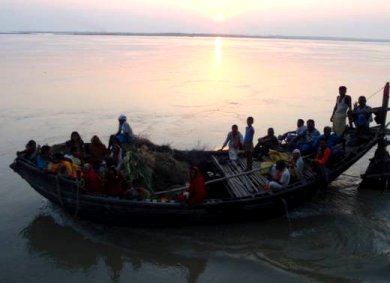
Local ferry
The revolt was brutally put down, but it did cause London to become aware of how poorly India was being administered by the East India Company. In 1858, the British parliament ended the rule of the East India Company and ruled that the territory then under the company’s control become part of the British Empire. Thus the ‘Raj’ – as the British rule was known – was born.
Nationalist aspirations grew among the Indians. They formed the Indian National Congress in 1885 as a platform for self-government. Progress was slow until 1919 when British troops fired on an unarmed crowd of protesters, and widespread national outrage at the British brutality followed.
In 1920 Mohandas Karamchang Ghandi took over the leadership of the national movement. He led a crusade of non-violent resistance.
While Ghandi was leading a movement for India’s self-government, the Muslim league, led by Ali Jinnah, demanded the formation of an independent state of Pakistan for Muslim Indians. All of these demands were ruthlessly repressed until World War II.
Following World War II, Britain was financially devastated, and they wanted to be rid of India. So, on August 15, 1947, the independent nations of India and Pakistan were formed. However, the partitioning of India caused mass migrations with riots and killings. It is estimated that 10 million were killed during the partition.
India’s first prime minister was Pandit Jawaharlal Nehru – a close associate of Mahatma Ghandi – and Nehru served until his death in 1964. The next two prime ministers were Nehru’s daughter then grandson, and they were both assassinated while in office. However, the current prime minister – Manmohan Singh – seems to be widely respected, and India’s government appears to be stable.
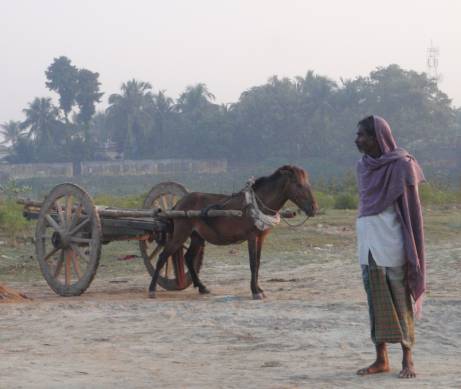
Taxi waiting for a fare
India includes almost 1.15 million square miles of land and occupies most of the Indian sub-continent. Its neighbor to the west is Pakistan; to the north are China, Nepal, and Bhutan; and to the east are Myanmar (Burma) and Bangladesh. The Indian Ocean is to the south.
The Himalayan mountains stretch across the northern border. Below are the Ganges plains which are wide and fertile. The Ganges plains are also among the most densely populated regions of the world. Below the plains is the Deccan peninsula. Climate varies from tropical in the south to near-Arctic cold in the northwest, and 49% of the land is arable.
The capital is Delhi with a population of 15 million. However, Delhi is only the third largest city in India: both Kolkata and Mumbai are larger.
India’s population is approximately 1.13 billion. It is a predominantly rural population with more than 70% living in rural areas. It is also a young population with more than half less than 25 years old.
The vast majority (81%) of Indians are Hindus. There are also Muslims (13%), Sikhs (2%), and Christians (2%). The numbers of followers of other religions, including Buddhists, are negligible.
The primary language is Hindi, but it is not spoken throughout the country. There are 16 official languages, and there are numerous other languages spoken with countless variations. We were pleased to find English spoken by many (it is one of the official languages), but it is definitely not spoken by all.
Unfortunately there is no compulsory education, and the national literacy rate is around 61%. This rate is higher in the cities than in rural areas, and it is higher among men than women.
India is a federal republic. The head of state is President Pratibha Patil, and the head of government is Prime Minister Manmohan Singh. There are 28 states, 6 union territories, and 1 national capital territory.
Some of India’s largest industries are textiles, chemicals, and software. Their chief crops are rice, wheat, oilseed, and cotton. Natural resources include coal and iron ore among others. Their labor force is 60% agricultural, 12% industrial, and 28% service.
The Indian currency is the Rupee (INR), and the current exchange rate is around 40 rupees to the US dollar. The rupee is currently worth about $0.025 USD.
Our trip was actually two trips taken sequentially (see itinerary). The first part was a land-based trip around Delhi and Agra. Then we flew to Varanasi for the second part of our trip which was a river trip down the Ganges. However, as noted below, the river portion was shortened by four nights which were also spent in hotels on land.
We flew in to Delhi, the capital of India. After exploring the capital – New Delhi and Old Delhi – we took the train south to Agra. Our first stop in Agra was the Taj Mahal, and it was magnificent. We explored a few other sites in Agra then returned by train to Delhi.
From Delhi we flew to Varanasi. What a culture shock! We spent a few days exploring Varanasi and the surrounding area before boarding the RV Pandaw IV – aka RV Bengal Pandaw – for our trip down the Ganges.
We spent ten days floating down the Ganges – stopping at both historic sites and small rural villages. We experienced a variety of Indian communities, and it was an enriching experience.
We actually traveled down three rivers – the Ganges, Bhagirathi, and Hugli. We went down the Ganges as far as we could until we came to the Barrage sluiceway beyond which is Bangladesh. We changed course to the south and entered the Farrakha Locks. Upon exiting the locks, we were in the Bhagirathi River. We continued down the Bhagirathi until it turned in to the Hugli River which runs through Kolkata.
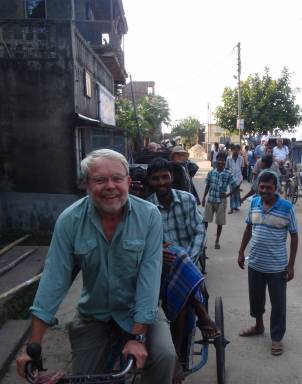
Bud got confused about who pedals and who rides
We also traveled through 4 states – Uttar Pradesh, Bihar, Jharkhand, and West Bengal – and in the capital territory of Delhi. We traveled by plane, train, boat (various styles and sizes), bus, car, horse cart, ox cart, bicycle rickshaw, and foot.
We visited craftsmen making Kashmir carpets, marble inlay, brocade silk, and brass. We visited a beetle leaf farm and an internationally known school of yoga. We visited villages that mine clay for china and sand.
On arrival in Kolkata, we disembarked and spent a few nights on land while we explored the city and surroundings. Kolkata was vibrant and colorful, and it was a great place to end our trip.
Throughout our travels, we saw that religion is the thread that weaves the fabric of India. Indian life revolves around religion whether Hindu, Muslim, Sikh, Christian, Buddhist, Jain, or other. Consequently, many of our experiences had strong religious undercurrents even when we were not visiting religious sites. Therefore, India’s religions – both past and present – seemed a logical framework around which we could organize our experiences.
However, we could not ignore India’s recent past of British colonization and its struggle for independence. We visited places that are meaningful to that struggle.
Therefore, rather than discussing our experiences in the chronology that we experienced them, we have chosen to discuss them as related to religion – specifically Hinduism, Buddhism, and Islam – India’s struggle for independence, and the aftermath of that independence. This format also enables us to provide a bit more history where needed to understand the significance of the places and events that we were privileged to visit.
Come with us as we look at the ancient origins of Hinduism and visit some of its temples and followers. Next we will further explore Buddhism and the path that Buddhist pilgrims follow in eastern India. Then we will look at the tremendous legacy from the Islamic rulers of India. The decline of the Islamic rulers coincided with the rise of the British Empire, and that was followed by India’s independence in 1947. These five categories somewhat parallel the chronology of India’s emergence from centuries of imperialism to independence. It was a very interesting journey.
Follow us as we begin our exploration with a look at Hinduism or return to our land travel page.